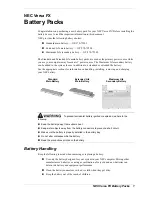
44
of each cell can be accurately determined from their terminal voltages. However, if the pack is used in a charge-
sustaining application, where it is rarely charged to its full SOC, the cell to cell voltage variation is more difficult to
ascertain, because in the mid-SOC range, the voltage is very flat with respect to SOC. Balancing decisions must be
made opportunistically under the following conditions:
•
The pack current is under C/2
•
The SOC is greater than 90% or less than 30% SOC (where the dV/dSOC is large)
Waiting for the current to be small eliminates errors due to resistive drops along the interconnecting bus bars and
straps. Waiting for the SOC to be near the upper and lower limits reduces the error due to the very small dV/dSOC
that the A123 cells exhibit in the middle ranges of SOC.
Fuel Gauging (Types, Methods)
There are a number of ways to estimate SOC, the “fuel” or charge that is remaining in the cell or battery. Due to an
inherent amount of uncertainty in each method, a combination of methods may be necessary to maintain a
reasonably accurate SOC measurement. In addition, different applications dictate the necessary level of accuracy,
so there is no single ideal method that works for every application. This section describes the following types and
methods that can be used for fuel gauging:
•
Voltage SOC (vSOC)
•
Coulomb Counting SOC (iSOC)
•
Combination of vSOC and iSOC
Voltage SOC (vSOC)
One method of determining SOC uses only voltage. Lithium ion batteries store a specific amount of charge at a
characteristic voltage potential. The amount of storable charge is specified by its amp-hour (Ah) rating. The
chemistry of the electrode materials determines the amount of voltage potential that drives the charge out during
discharge and must be overcome during recharge. A123’s Nanophosphate® chemistry produces about 3.3V on
average during a discharge. This voltage is dependent on a number of factors, including current, history, age,
temperature and SOC. Figure 21 shows the open circuit voltage (OCV) voltage compared to Depth of Discharge
(DoD) of the AMP20 cell.
The BMS takes a reading of the OCV and correlates it to the SOC using look-up tables based on the graph in Figure
21. The problem with this algorithm is that the voltage readings need to be extremely accurate for the A123
battery technology. There are a couple of flat portions in the middle ranges of SOC, which are less than 1mV per
1% SOC. If a BMS were to rely on voltage alone for its SOC estimates, it would be required to have extremely
accurate voltage sensing capability, on the order of 1mV resolution and accuracy per series cell. In addition, the
battery current affects the voltage reading proportional to the battery impedance, which depends on a number of
factors such as temperature, age, and previous operational history. Figure 22 illustrates the possible range in SOC
values resulting from uncertainty measuring OCV.
It is appropriate to mention
hysteresis
at this point. There are two OCV vs. SOC curves that the battery exhibits
depending on whether it just delivered a discharge or received a charge. For any given battery SOC, an open circuit
reading taken after the current goes INTO the battery will result in one voltage, while an open circuit reading taken
after current is taken OUT of the battery will result in another. The difference between these two voltages varies
















































